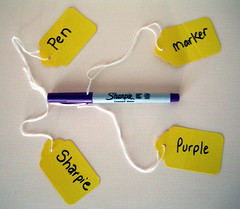 It seems every conversation I have with someone here or overseas starts with some comment about “these times we are in.” Moreso for my US colleagues, but the change in economic times is on everyone’s mind. I’m doing more work online and less on the road. Budgets for current projects are sticking pretty steady, but no one seems to know what tomorrow will bring. For us independents, this uncertainty is nothing new, but clearly the playing field has changed.
It seems every conversation I have with someone here or overseas starts with some comment about “these times we are in.” Moreso for my US colleagues, but the change in economic times is on everyone’s mind. I’m doing more work online and less on the road. Budgets for current projects are sticking pretty steady, but no one seems to know what tomorrow will bring. For us independents, this uncertainty is nothing new, but clearly the playing field has changed.
However, I am blessed that I don’t have to lay any one off. I read about closures and layoffs and friends are losing their jobs and it breaks my heart. I feel pretty powerless and am doubling my efforts to help others in my network find gigs. Relationships and networks matter now, more than ever.
But what are leaders of organizations to do when their budgets are slashed by 20, 30 and even 50%? I look at my State’s budget shortfall and know there are no easy paths. Difficult times call for leadership in many forms and at every level, both formal and informal.
When I read Dan Oestreich‘s Reflective Leadership in the Age of Layoffs, I said “aha!” I must share this with my husband who, as a middle manager, is fighting the budget and morale battle every day. Dan writes:

Most managers I know do not feel they’ve actually been given much guidance about how to proceed with cost cutting and, particularly, layoffs. As the first line of a recent Harvard Business Review article asks,“Why aren’t layoffs taught as a subject at business school?” I assume the reason is that the subject is both very complex and comes far too close to what it really means to lead, touching that sensitive cross-over point between personal values and professional conduct, a place where theory definitely has its limits.
Dan encourages us to slow down, to reflect, to ask questions that matter. This is good advice for any tough decision regardless of the economic environment. Dan writes:
…in addition to the fact that the leaders all seemed pretty much adrift and self-enclosed, is their push to simply get together in a room, have some hurried discussion, and then decide what needs to happen. The role of reflection seemed to be bypassed in this rush to create the right strategy — and then, ipso facto, to know what to do. Surely, when the financial heat is turned up, there’s no time to waste, but this is also a time when alignment with real brand values — a topic that requires reflective leadership as a team and as individuals — is likely to be the most reliable long-term guide. Understanding and applying these values demands decisiveness founded on thorough and creative consideration, not some three hour “tall grass” meeting where competing self-interests have a field day, followed up by a briefing and hand-out from Human Resources.
It’s as if no one wants to ask the telling question, “Wait a minute, what was this place supposed to be about, anyway?”
I encourage you to read Dan’s article. It is fabulous from beginning to end and offers some practical advice about how to lead in a time of layoffs. Then think about your strategy for decision making and leadership in uncertain times. What are you doing? What values are driving your decisions? How are you living those values in every step? How can we prepare ourselves to make these hard decisions? How do we account for our responsibility to others in our decisions?
For me, here are some of the things I’m doing with my clients. They are tiny, piddling things when compared to the scale of things in organizations.
- Do we have to meet face to face at this moment in time, or can we save time, money and carbon into the environment and meet online and on the phone? Doing this with a recent client saved them a $600 ticket and 16 hours of my billable travel time. The final outcome of the work is not visible yet, but I think I delivered quality consulting in a way that was probably more flexible than if we had met face to face. (And I have more time with my family!)
- Is some one else doing something similar to what you have to do and can you do it together to share the costs (and benefits!)? Right now I have two pairs of clients who are cross fertilizing their work and sharing some things with each other. This is bliss for me and saves them time, money and they can focus on their own work more closely.
- What can be deferred? What is most important and valuable now? I think this is the toughest one, because it is easy to become short sighted in tight times. Really asking ourselves the hard question about how we invest our time and resources is critical. We can’t forget about tomorrow as we consider today.
- How much can I not spend to keep my costs down? Both in terms of my own business and with my clients? I tend to be thrifty (some say ‘cheap’) but it is easy to fritter money away on things that don’t really matter. It helps that I work at home, away from shops and places to eat out. When I do shop and eat out, I am trying to patronize businesses in my local neighborhood.
Related to this is a great piece by Peter and Trudy Johnson Lenz on Six Habits of Highly Resilient Organizations .Here is a snippet of the habits. Do read the whole article! It makes me reflect on my own little one-person organization!
- Resilient organizations actively attend to their environments.
- Resilient organizations prepare themselves and their employees for disruptions.
- Resilient organizations build in flexibility.
- Resilient organizations strengthen and extend their communications networks – internally and externally.
- Resilient organizations encourage innovation and experimentation.
- Resilient organizations cultivate a culture with clearly shared purpose and values.
I don’t know what tomorrow will bring. I know our family is blessed and recognize so many are struggling. I’d love to hear your advice about how you are leading in difficult times… Again from Dan…
In troubled times, reflective leaders step back to witness…and to learn.


 Organising and manage their own content
Organising and manage their own content
 It was
It was 